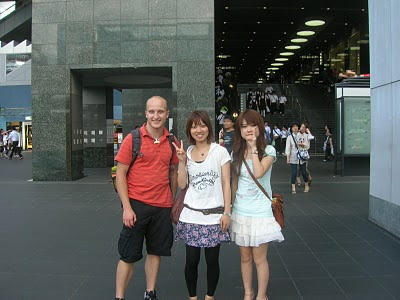 |
| The panorama of Kyoto from Daimonji, taken exactly from the center of the 大. |
The one thing that I find the most exciting about Japan is its physical landscape. You might wonder why I didn't say food, girls, manga, kimonos, shrines, temples, high-tech robots, or something like that; all these things are great, but the greatest thing about Japan is that there are mountains almost everywhere you look. Mountains cover most of the country and envelop small strips of flatlands around the coastline, where most of the major Japanese cities are located. Surrounded by mountains, the size of Japanese cities is determined exactly by where these mountains begin, which is also probably why everything in Japan is so small, with many things packed into small spaces. This Japanese flatland-mountain divide creates a sharp contrast between everything urban and everything not urban, to which Kyoto is no exception. This topographic feature makes it really easy for me to get out of the city whenever I feel like it, and because I am not known to be a stubborn city dweller, I feel like it quite often.
So far, I have hiked to the top of three mountains (or hills, considering neither of them topped 1000m (3300 ft). The weekend before the last I hiked up the Daimonji Mountain with Becca, an American friend of mine. Daimonji , written 大文字, literally means “Chinese character for great” (大). In other words, there is a huge “Great” (大) carved into the mountain and it can be seen from very far away, including Doshisha’s Imadegawa campus, which is where I go to school. It shouldn’t then surprise you that when I first noticed this mountain, I knew I had to hike it. Interestingly enough, there are four other such mountains with different characters on them scattered around Kyoto, and all of them can be seen from the center of city. In the night of Aug 16, as a culmination of the famous Obon festival, the five characters are lit up and literally burn for about thirty minutes. Unfortunately, I won’t be here to see this spectacle. The view from Daimonji was amazing, and the Kyoto Tower, which I went up several weeks ago during orientation, looked like a tiny needle in an enormous haystack.
This Saturday, me and Kohei, a Japanese friend of mine living in the neighborhood, went on a short bike ride. Or so we thought. We left my house at around 11am and biked to the mountains just east of Seika (my town, remember?). Instead of returning in an hour or two, we took about four and a half. We biked east through Seika’s rice fields, across the Kizugawa River, and into the mountains covered with bamboo forests and tea fields which surround the cedar-covered peaks of the Yamashirocho Forest Park. The roads there are very narrow and there are barely any cars in them, which exemplifies the contrast between urban and not urban in Japan that I mentioned in the beginning. We biked through the park and got to a sign which said 三上山 (Sanjo Mtn) 5km. Thinking that 5km would take no time on a bike, we took the road to Sanjo. After a while it became impossible to bike because the road changed into a small, steep forest path. We locked our bikes and started hiking (even though no one actually steals bikes in Japan, locking them is a cultural necessity). Obviously no one took this path in a while because we ended up having to hike with a long stick in front of us in order not to get covered by huge, sticky spider webs every other step (but just every fourth). When we got to the top, it was already 1pm, but the view was absolutely worth it. We could see Seika to the west below us, and mountains to the east behind us, a gorgeous view. We enjoyed the view for a while, took a picture, and left. Interestingly enough, neither Kohei nor anyone from my host family, though they’re all native to the area, have ever been to the Yamashirocho Forest Park or to Sanjo. It’s funny that the locals need a foreign tourist with them to finally discover the beauties of their own neighborhood.
On Sanjo, we met a man who recommended us two other mountains to hike, Mt Atago and Mt Kurama. Me, Becca and Masa (short for Masakazu, another Japanese friend of mine), hiked up Mt Atago the next day. With its 924 meters above sea level, Mt Atago is more than twice as tall as the four-hundred-something Daimonji and Sanjo. Similar to Daimonji, Atago is a popular weekend destination and therefore full of people like the three of us, desiring to escape the city’s grasp for at least an afternoon. The amount of people hiking up and down the mountain actually makes the hike feel like walking up a tilted Champs-Élysées, with trees instead of old buildings and with a Shinto shrine on top instead of the Arch of Triumph. In fact, many people visit the shrine on top to pray to the Kami (Japanese “gods”) and buy all kinds of talismans and other trinkets for considerable sums of money. Masa bought himself a plain piece of paper for seven hundred yen, the equivalent of 8 USD. Apparently it was blessed. The view from Atago is even better than from Daimonji in terms of distance, but you can’t see too far in general because of the ever-present haze surrounding much of Japan during the hotter months. We hiked down a different route, which, for a change, led through a Buddhist temple.
If the weather forecast is right, it should rain in Kyoto this weekend, and so my hiking will probably be either suspended or quite wet. The latter will likely be the outcome. I’ll keep you posted.















